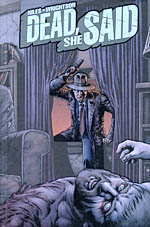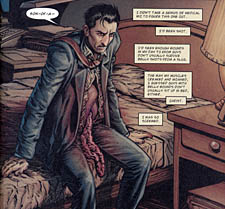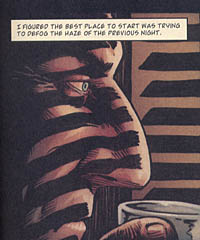 Written by Steve Niles
Written by Steve Niles
Art by Bernie Wrightson
104 pages, color
Published by IDW
Does everyone remember those old commercials for Reese’s Peanut Butter Cups, where two people’s personal peanut butter and chocolate collide and the end result startles them into how good the mixture is? Well, I blame those commercials for every sort of mixture of genres, tastes, or ideas. Fusion restaurants, rap/rock duets, you name it, I know the cause. I’m not saying that they’re bad, just that I know exactly where they’re coming from. And now, to add to that list, Dead, She Said‘s mixture of pulp noir and 1950s science-fiction. Two great tastes you may have never thought of mixing together.
 Detective Coogan’s woken up with a hangover before, but never with his guts hanging out of his stomach. It seems that someone has killed Coogan—but somehow, miraculously, he survived the experience. Can he figure out who killed him before his flesh rots entirely off of his body? How long until his smell gives away his condition? And what’s going on with the missing people from outside of town?
Detective Coogan’s woken up with a hangover before, but never with his guts hanging out of his stomach. It seems that someone has killed Coogan—but somehow, miraculously, he survived the experience. Can he figure out who killed him before his flesh rots entirely off of his body? How long until his smell gives away his condition? And what’s going on with the missing people from outside of town?
When I first started Dead, She Said, I was completely on board. The book has all the hallmarks of an old noir detective story; not just the narration and feel of those old pulp novels, but even the hallmark visuals like Coogan looking out through the venetian blinds with the shadows patterned on his face. And then, suddenly, we have a mad scientist creating a gigantic-sized ant colony with mind-controlled subjects serving the humanoid insects. To me, the book never really recovered. Maybe it’s because while the horror elements of Dead, She Said and the detective elements meshed so well together, the science-fiction bits also being added in just never quite fit. It was one addition too much, and the three styles just clashed back and forth with each other. It’s strange, because I think had it either been detective/science-fiction or detective/horror, it would have been all right. Coogan’s a fun character to read about, and Niles certainly has fun with the supporting cast as well. But all three together? It just wasn’t working for me.
 I do quite like Wrightson’s art for all of Dead, She Said, though. He’s an extremely versatile artist, and he tackles anything and everything that Niles throws at him with aplomb. When you’re looking for someone to draw gruesome or out of the ordinary, look no further; that first scene with Coogan waking up is gut-churning (no pun intended), and the looks of terror on the innocent bystanders as they’re being snatched help amp up the tension. The only bit of the art I wasn’t so sure about was Grant Goleash’s colors. While I loved his collaborations with Eduardo Risso on the early issues of 100 Bullets, here the art seems a little too dark and muddy in some places, obscuring parts of Wrightson’s art. For fans of Wrightson’s art, though, the 30 pages of bonus material will be sure to delight; with random pin-ups and illustrations from over the years, it’s a Wrightson jackpot just waiting to be had.
I do quite like Wrightson’s art for all of Dead, She Said, though. He’s an extremely versatile artist, and he tackles anything and everything that Niles throws at him with aplomb. When you’re looking for someone to draw gruesome or out of the ordinary, look no further; that first scene with Coogan waking up is gut-churning (no pun intended), and the looks of terror on the innocent bystanders as they’re being snatched help amp up the tension. The only bit of the art I wasn’t so sure about was Grant Goleash’s colors. While I loved his collaborations with Eduardo Risso on the early issues of 100 Bullets, here the art seems a little too dark and muddy in some places, obscuring parts of Wrightson’s art. For fans of Wrightson’s art, though, the 30 pages of bonus material will be sure to delight; with random pin-ups and illustrations from over the years, it’s a Wrightson jackpot just waiting to be had.
I wanted to like Dead, She Said more than I did. It’s by no means a bad book, but it just felt like it had too many ideas and concepts crammed into its pages. In some ways it almost felt like two separate stories that ended up being pushed into a single volume. If Niles and Wrightson bring the book back for more, I’d certainly welcome its return; hopefully the next time through it would just have slightly less cross-genre material and focus more on a singular idea. Good, but could have been so much better.
Purchase Links: Amazon.com
